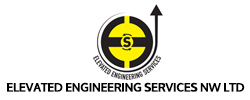Let us help you to reduce your costly failures and keep your machinery moving.
What is Thermography?
As an object gets hotter, it emits more radiation in the infrared part of the electromagnet spectrum. With a device that can measure infrared radiation you can measure the temperature of an object. We call this device an infrared camera and we call the science of its use “Infrared Thermography”.
Using the best cameras available and with a reporting system second to none, thermographic techniques can be used to detect a host of different problems with your equipment i.e. Gearbox Wear, Predictive Bearing Failure and Electrical Faults etc.
Thermography will give a complete health check to all types of gearboxes thus enabling planned outage – repairs carried out over a weekend or during holidays etc.

Bad connections in motor terminal box

Figure 1 – Hot spot located around the motor terminal box
Sp1 on the thermogram indicates a hot spot recorded in excess of106 degrees C, this was located around the motors terminal box, when monitoring motor casings it is important to trend the size and shape of anomalies, historical data can often help you identify a change in pattern which enables you to establish a rate of possible deterioration.
This drive had a critical alarm set at 120 degrees C so even though the hot spot had not exceeded this the location of the anomaly when compared to historical profiles was a cause for concern.


Figure 3 – Motor was changed
The motor was actioned in the report to check the inside of the terminal box, even though the thermogram was indicating there may be something suspicious going on nobody expected to see what they found. The motor was changed under a controlled shutdown, if this had been left unattended the implications could have been severe.

Figure 4 – Bad connections
These pictures are a good example of highlighting the issue of trending, even though thermography is an excellent condition monitoring tool because it is so visual it is easy to get caught out by focusing purely on the temperature.
Just because it looks clean it doesn’t mean it is clean!!!

Figure 1 – Hot spot located on motor core
Sp1 on the thermogram indicates a hot spot recorded in excess of 120 degrees C, this was located around the motors core. When monitoring motors the core should be the hottest position on the casing the insulation that surrounds the motors core is rated for its size and classification, when the maximum limit is breached this has a dramatic effect on the life cycle of the machine.

Figure 2 – Visually the motor looked clean
Visually the motor casing did not appear to be that dirty, the fins looked clear from debris and the cowling was free from dust.
These drives are on a cleaning system where the casings are brushed by hand to try and keep the build-up down.

Figure 3 – Casing after the motor was cleaned
The motor was actioned in the report and the underside of the casing was cleaned as an interim measure before an internal clean could be completed during a scheduled shut.
This had an immediate effect with casing temperatures on the core reducing by 40 degrees C.

Figure 4 – Hardened dust particles
The back of the machine is extremely dusty, the air has a high moisture content and hosing down is a regular occurrence.
Unfortunately this is a bad combination for motors as this hardens the compacted dust which immediately acts as an unwelcome insulator on the motor casing. aving the correct cleaning procedures for motors is an integral part of a preventative maintenance program, it doesn’t take much but it certainly saves a lot!!
What’s behind the door?

Figure 1 – Thermal image of cabinet with door closed – nothing to see!!
The door has then been opened to reveal burnt insulation on the centre connection of the contactor. The excessive heat does not exceed 60 degrees C during the time of survey, which explains why this will not have transmitted through the door. However you can clearly see this has been operating at much higher temperatures than those recorded during the inspection.

Figure 2 – Visually the insulation was perished
Visually you could clearly see the insulation had perished which you would expect to see as a result of the extreme temperatures it was subjected to.

Figure 3 – Connection temperatures post remedial action
A work request was raised and the connection was cleaned and remade which you would expect to have resolved the problem. However what we did record were temperatures exceeding 200 degrees C on the opposite side of the contactor. This time we had to dig deeper and look for a root cause to this problem. The contactor was removed and it was clear the fault was actually with the component and not the connection.

Figure 4 – Contactor with internal fault
Quarterly inspections are conducted on these cabinets, load demands fluctuate and components are often subjected to operating in harsh, dirty environments. It is important to have a thorough understanding of your target object so you can establish a fault classification criteria, making a note of load changes will also help you to analyse trends more accurately. Communicating your results and checking completed remedial work enables you to confirm your initial findings have been accurate and the work has been completed to a satisfactory standard. Look for the root cause to try and stop the fault occurring again.
Thermography is an extremely powerful technique, used correctly it can reveal a multitude of sins, but remember…..it can’t see through doors!!
If you would like an engineer to come out to you to complete a survey please fill in the Enquiry Form below
Thermographic Survey Enquiry
